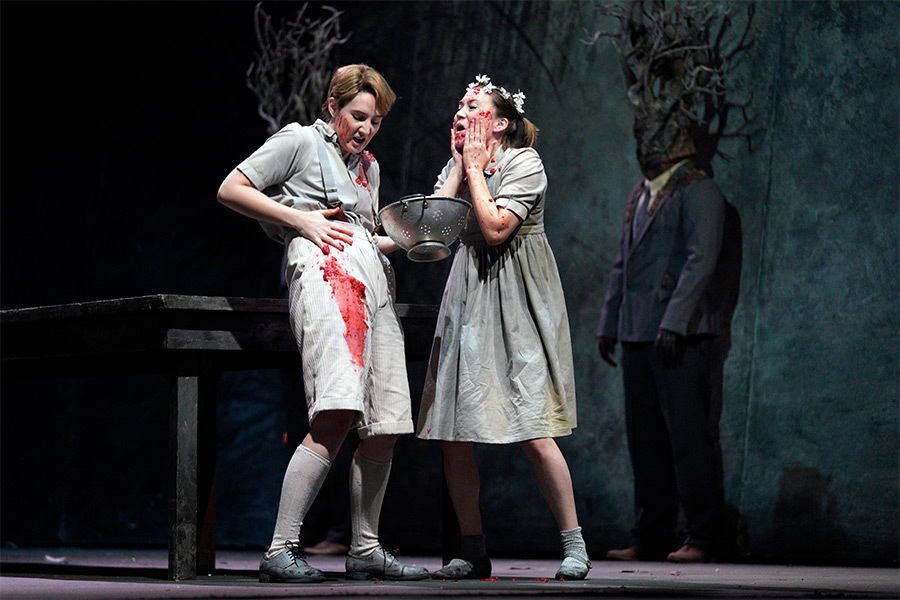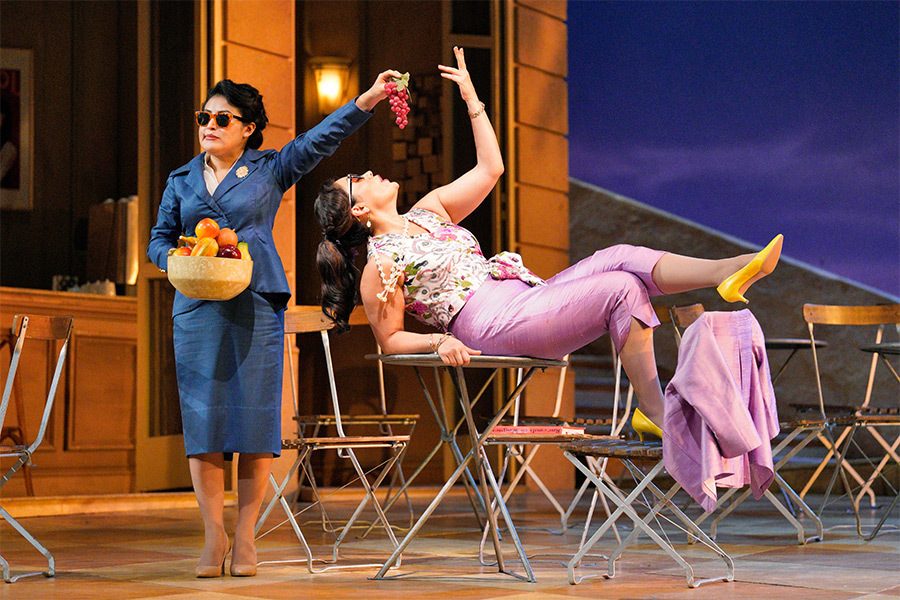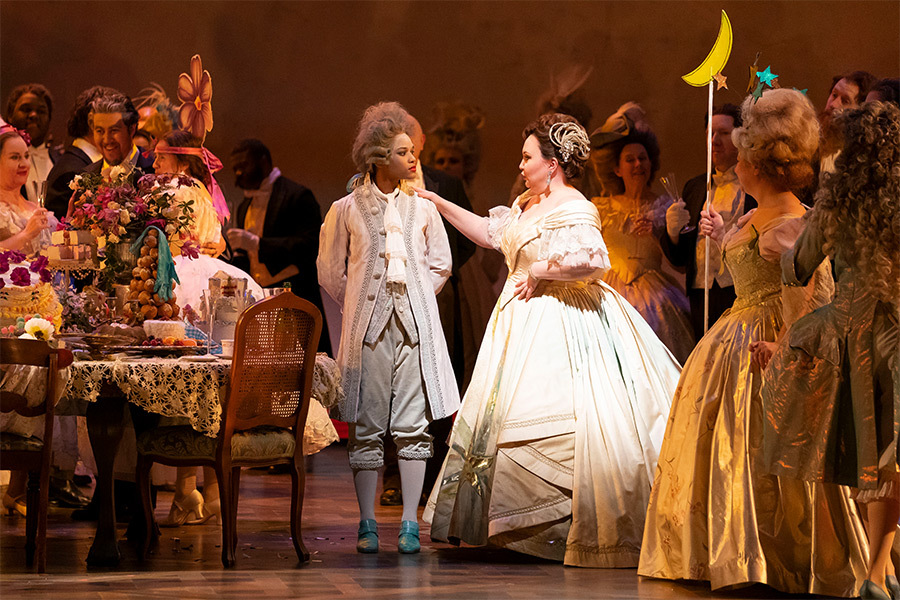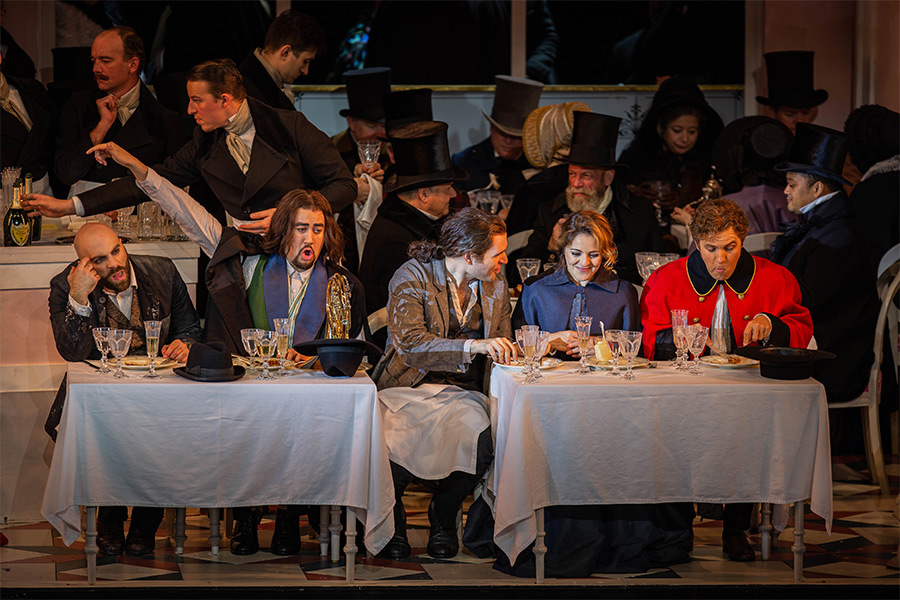February 04, 2025
Feast on Opera
In recent seasons, Lyric audiences have traveled down the Amazon River alongside Florencia Grimaldi in Florencia en el Amazonas (2021/22), walked along the streets of 19th century Paris with Mimì and Rodolfo in La Bohème (2018/19), witnessed the splendor of the gingerbread house in Hansel and Gretel (2022/23), and seen 17th century Rome come to life in Tosca (2021/22). What unites all of these different stories? Food! Maria DeFabo Akin, Lyric’s Production Design Director provides a behind-the-scenes look at how delicious meals and extravagant feasts are prepared for Lyric’s stage.

Tevye dining in Fiddler on the Roof (2022/23)
Were there any opera productions where food played a significant role in the storytelling? If so, how did you incorporate food on stage?
La Bohème is a great example of an opera that utilizes food to tell a story. Several of the story’s scenes occur in places that encourage dining or drinking, such as a tavern and a café. While the love story of Mimì and Rodolfo often steals the spotlight, the meals that take place throughout the performance are just as important. For the food design in La Bohème, we had to place a large catering order to ensure that we had enough food to make the atmosphere as lively as possible. Ultimately, there was a ton of chicken, green beans, and potatoes. Admittedly, we’ve often used potatoes over the years — they can be seen in Traviata, Hansel and Gretel, and many more performances. They’re a versatile food that can be found across many countries and time periods.
Overall, the meals on stage will vary depending on the tone of the production, lighting and set design, the time period in which the story takes place, and the relevance that food bears on the story. In Hansel and Gretel, for example, food serves as both nutrition for the children and a tool for the Witch to lure them inside the gingerbread house. Since Hansel and Gretel often interact with food items on stage, such as when they pick strawberries in Act II, we had to pay extra attention to how the food lingered on surfaces and stained clothing. Even when food on stage isn’t directly consumed, we need to ensure that it looks natural and accentuates the performance.

Hansel and Gretel after picking strawberries (Hansel and Gretel; 2022/23)
What factors influence the decision to use real or prop food in a production, and how do you ensure the safety and hygiene of real food items on stage?
While prop food can be used to enhance a scene, we frequently use real food on stage if a singer is scripted to interact with it in some way. Any time we use real food on stage, we have to ensure that it's prepared safely and fits within the dietary restrictions of the singer and any nearby performers. Each show is different, but we always make sure to gather pertinent information and ensure safety through proper sanitary and hygienic practices. We also typically have to assess the individual production and what is needed from the food on stage to determine whether real or prop items would be more appropriate.

Fruit used in The Elixir of Love (2021/22)
What is the process of selecting or creating prop food items, and how do you assure they look realistic on stage?
We often receive sketches or ideas from a designer. Sometimes, we just get a simple note from rehearsal requesting some food props. From there, we meet up to determine how to fulfill the designer’s wishes and create a detailed atmosphere that intrigues the audience. For instance, when we did Florencia en el Amazonas, there was a scene in which singers would visit a dock and pick up fish, as if to sell them. The fish weren’t actually consumed; however, since the fish were held by the performers, Peter Davison (Lyric’s Set Designer) wanted them to look as lifelike as possible. To make the props more realistic, we worked with our Scenic Artists to design a mold and create fish with silicone bases. The material selection helped make it look authentic, as the silicone allowed for movement that perfectly mimicked a live fish being sold at a market. That small detail ended up making a big difference on the liveliness of the scene.
We’ve also been tasked with creating giant tables with decorated cakes (seen in The Marriage of Figaro and Traviata). For those designs, we used a mixture of plaster over foam forms to make giant cakes. Paying attention to specific details can make food look more realistic, so we added cherries, sprinkles, frosting, and other decorations. We have some tricks up our sleeves too. For example, to make a fake turkey look freshly cooked, we can paint on a shiny glaze and make it slightly glossy. In addition to enhancing the details of the props, we also dress the dishes and the table. Things such as silverware, napkins, and table settings are subtle ways to add realism to a dining table or eating area.

The elaborate table decoration in La Traviata (2018/19)
How do you handle issues related to dietary restrictions or allergies among cast and crew when food is involved in a production?
For Hansel and Gretel, we had a vegan cast member, and the understudy had a gluten free diet. We had to be ready for both individuals to go on stage at any time, so we reached out to the catering company from The William B. and Catherine Graham Room to make us some cakes. This ensured that the food was vegan or gluten free as needed. Thankfully, there are a lot of catering and food options in Chicago, so once we acquire the information we need, we can plan accordingly.

The elegant table settings in La Bohème (2018/19)
Are there any specific challenges or memorable experiences you've had while working with food in opera productions that you'd like to share?
We’ve had our fair share of memorable moments, but one experience in the 2004/05 season takes the cake. During Tosca, Sam Ramey played Scarpia, and he was instructed to sit at a small table and eat on the right side of the stage as the curtain moved. At the time, Ramey entrusted Charlie with providing food for him to eat during the scene. We ended up trying to make him salmon in the new convection oven that we just got. However, the oven malfunctioned and the salmon was still raw. We were running on a tight schedule that night, and so Charlie had to run over to Ramey and tell him not to eat the salmon, since it wasn’t cooked. As a joke on opening night, Charlie covered the dish with a fast food bag and told him the food preparation went wrong again. Thankfully, the bag was removed before Ramey went on stage — revealing his cooked salmon! We had a good laugh afterwards. Opening night can be stressful, but moments like that help to lighten the mood.
Designing food, whether real or fake, can come with challenges. It’s often difficult to source certain foods when they’re out of season. For example, seasonal fruits like pineapples and mangoes can be hard to find in the winter seasons. Of course, there’s always a risk for complications and issues — especially with bigger catering orders. It’s pretty important that we plan ahead and anticipate any issues, so that we have a backup plan in case things don’t go smoothly. Design can be a difficult battle, but we find that it’s often worth it. It’s always immensely rewarding to see the stage come to life during the productions.
